Crafting soap with tallow gives you superior quality bars that are hard, long-lasting, and naturally moisturizing. You'll create a creamy, gentle lather that's perfect for all skin types, thanks to tallow's rich nutrient profile of vitamins A, D, E, K, and B12. As a sustainable choice, tallow transforms meat industry byproducts into premium soap while cutting your production costs. This centuries-old tradition offers modern soap makers countless benefits that extend far beyond the basics.
The Historical Significance of Tallow in Soap Making
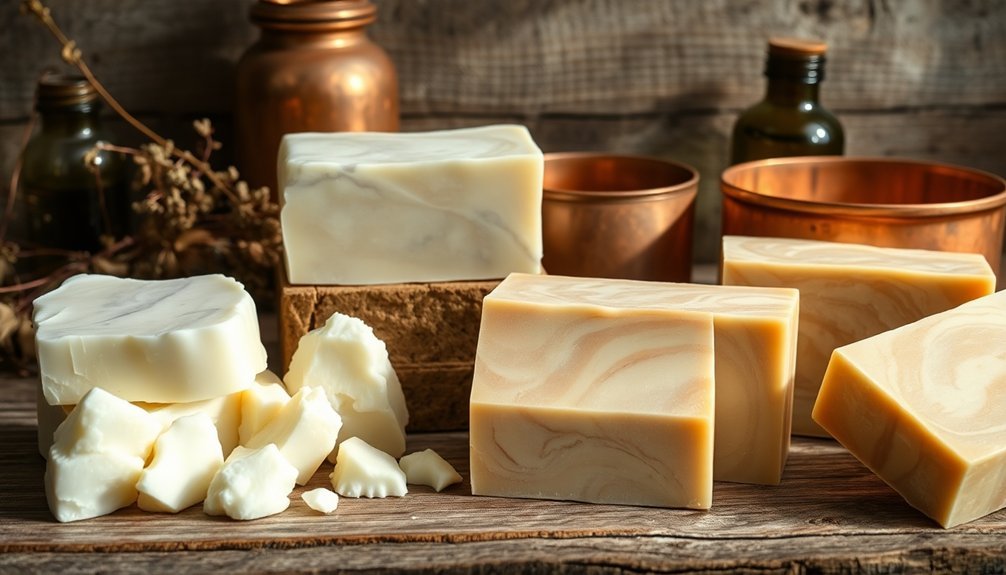
Three ancient discoveries shaped human civilization: fire, the wheel, and soap. When you explore the historical significance of traditional soap making, you'll find that tallow played a vital role in human hygiene for centuries.
This animal fat became the cornerstone of soap production when ancient civilizations discovered saponification, combining it with wood ashes to create cleansing bars.
Throughout history, you'll see tallow's prominence in European and colonial American households, where it was valued for producing hard, long-lasting soaps.
During the 19th century, tallow soap dominated the market as an essential household item.
Today's revival of traditional soap making techniques has brought renewed appreciation for tallow's sustainable qualities, connecting modern crafters with centuries-old methods that have proven their worth through generations of use.
Understanding Tallow's Unique Properties for Soap
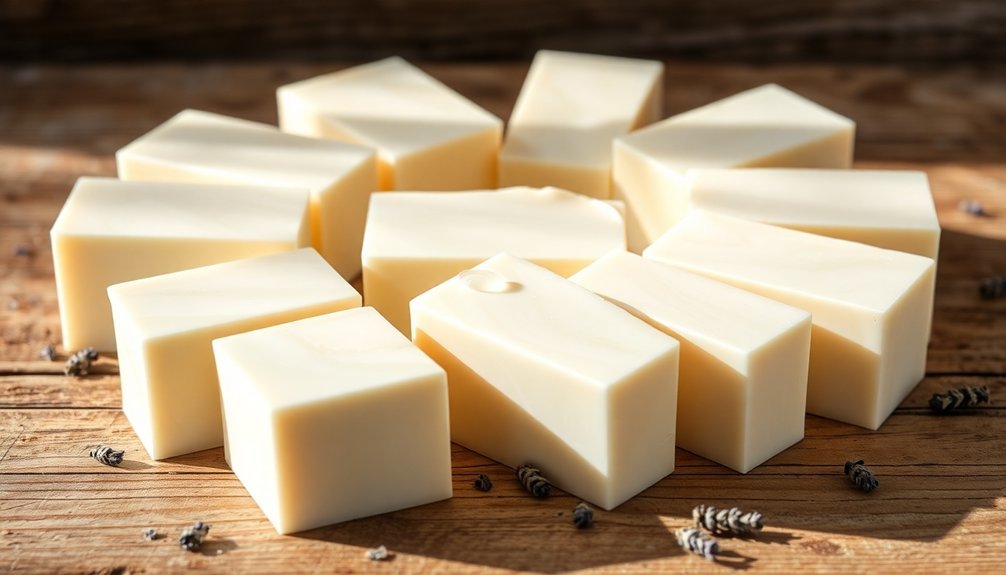
When you examine tallow's remarkable properties for soap making, you'll discover why it has remained a prized ingredient for centuries. Its unique composition mirrors human sebum, enhancing skin absorption and natural moisturizing benefits. You'll find that any tallow soap recipe produces bars with exceptional hardness and longevity.
| Property | Benefit |
|---|---|
| Fatty Acid Profile | Superior hardness and durability |
| Sebum-like Structure | Enhanced skin absorption |
| Quick Trace | Faster production time |
| Sustainable Ingredient | Cost-effective and eco-friendly |
The creamy lather you'll achieve with tallow soap provides gentle yet effective cleansing action. As a sustainable ingredient, tallow transforms meat industry byproducts into premium soap bars, making it both environmentally conscious and economical. You'll appreciate how its natural properties contribute to a superior final product that's both mild and nourishing.
Essential Benefits of Using Tallow Over Plant Oils
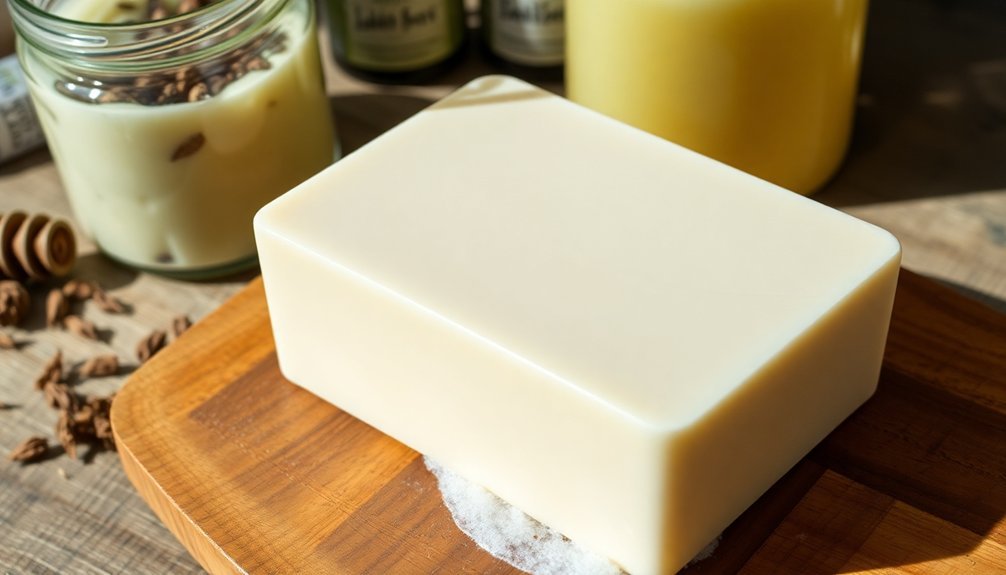
You'll find that tallow offers a unique combination of sustainability and superior soap quality, as it transforms a meat industry byproduct into a valuable crafting resource.
Your skin benefits from tallow's rich nutrient profile, including vitamins A, D, E, K, and B12, which provide natural nourishment that many plant-based alternatives can't match.
The hard, long-lasting bars you'll create with tallow maintain their structure better than plant oil soaps while delivering a creamy, moisturizing lather that works for all skin types.
Sustainability Meets Superior Quality
Making soap with tallow stands at the intersection of environmental responsibility and superior craftsmanship. When you craft tallow soap, you're embracing sustainability by repurposing animal fats that would otherwise go to waste. This ethical practice supports responsible consumption while delivering exceptional quality.
You'll find that tallow's unique composition creates bars that last longer and won't turn mushy like some plant-based alternatives. The creamy lather it produces provides natural moisturizing benefits, as its structure closely resembles your skin's sebum.
Plus, it's cost-effective compared to premium plant oils, making it an ideal choice for both beginners and experienced crafters.
Natural Skin-Nourishing Properties
The natural skin-nourishing properties of tallow set it apart from conventional plant oils in soap making. When you craft soap with tallow, you're harnessing a powerful combination of vitamins A, D, E, K, and B12 that actively promote skin regeneration and overall health.
You'll find that tallow's composition mirrors your skin's natural sebum, allowing for superior absorption of these essential nutrients. As a natural moisturizer, tallow's high oleic acid content penetrates deeply into your skin without clogging pores, effectively locking in hydration.
You'll also benefit from tallow's antibacterial and antimicrobial qualities, which help soothe common skin conditions like rashes and inflammation. These properties, combined with tallow soap's creamy lather and long-lasting durability, make it an exceptional choice for crafting skin-nourishing soap bars.
Sourcing and Preparing Quality Tallow for Soap
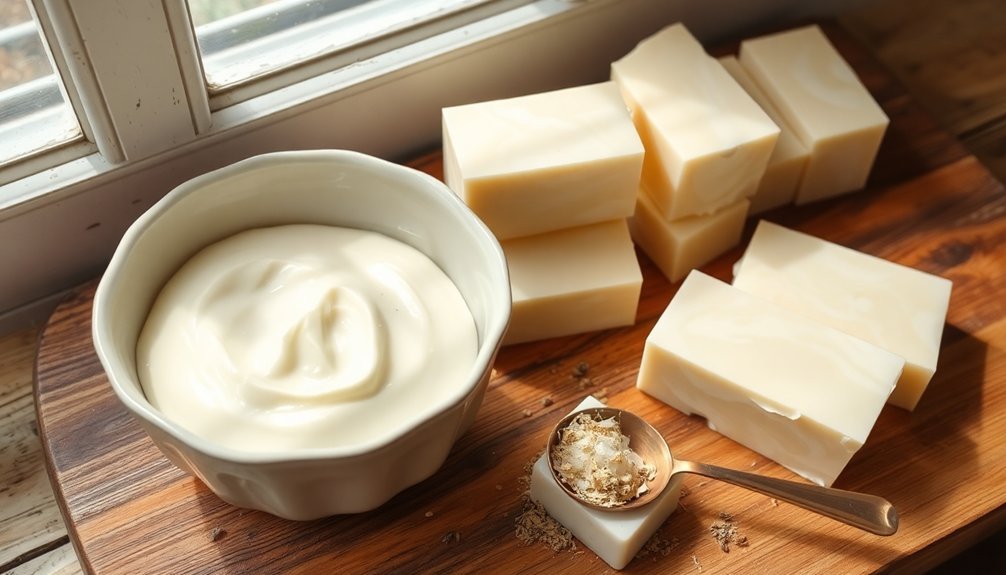
Before beginning your soap-making journey with tallow, sourcing high-quality beef fat and preparing it correctly are essential steps that will impact your final product.
You'll find the best tallow at local butcher shops, where unrendered fat is often available at budget-friendly prices. When sourcing, opt for grass-fed beef fat, as it's rich in skin-nourishing vitamins A, D, E, and K.
For properly rendering the fat into quality tallow, follow these steps:
- Cut the raw fat into small, uniform pieces
- Heat slowly over low temperature to prevent scorching
- Strain thoroughly through fine mesh or cheesecloth to remove impurities
- Store in airtight containers in a cool, dark place
This careful preparation guarantees you'll have clean, pure tallow ready for soap making, with a mild scent and ideal properties.
The Chemistry Behind Tallow-Based Soaps
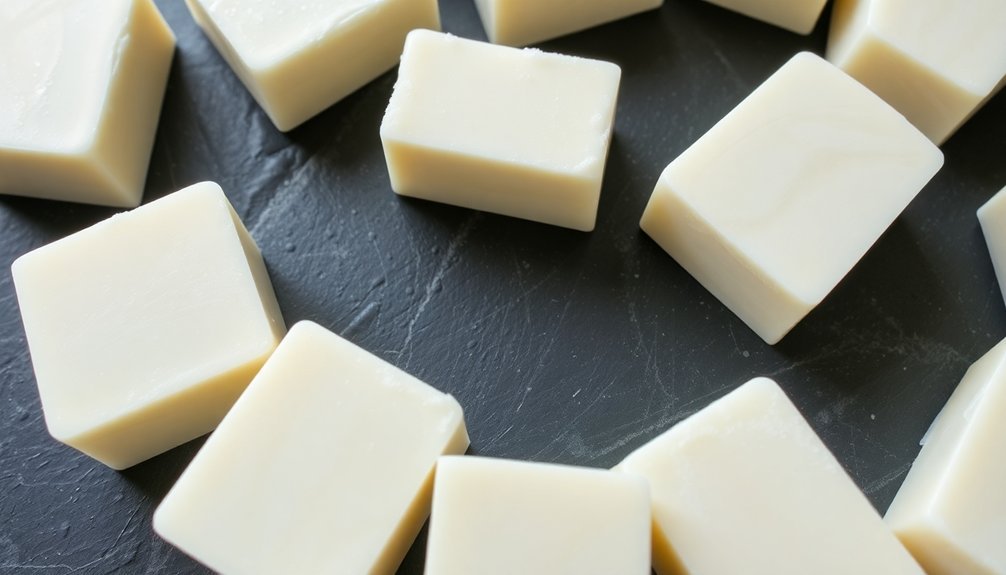
When you mix tallow with lye, you'll trigger a saponification process where fatty acids break down and recombine into soap molecules with distinct cleansing properties.
The high concentration of palmitic and stearic acids in tallow's molecular structure creates a harder, more stable bar that won't quickly dissolve in water.
You'll find that tallow soap maintains an ideal pH balance for skin care, thanks to its natural composition that includes moisturizing oleic acid and balanced fatty acid ratios.
Fatty Acid Saponification Process
Making tallow-based soap involves a fascinating chemical transformation called saponification. When you combine tallow with lye, the fatty acids break down and convert into soap molecules, while glycerin remains as a natural moisturizer.
You'll need a precise 33% lye concentration to guarantee your homemade soap is properly saponified without excess alkali.
During saponification, you'll observe these changes:
- The tallow's solid fats begin to melt and combine with the lye solution
- The mixture gradually thickens as fatty acids react with the alkali
- A creamy consistency develops as soap molecules form
- The mixture sets into a firm bar as the process completes
The type of tallow you choose matters, as different animal sources have unique fatty acid profiles that'll affect your final soap's characteristics and hardness.
Molecular Structure Benefits
The molecular structure of tallow creates an excellent foundation for soap making, thanks to its rich concentration of saturated fatty acids. When you're crafting tallow soap recipes, you'll notice how quickly the fatty acid components react with lye provides, resulting in a faster trace and more efficient production process.
You'll appreciate how tallow's unique molecular composition mirrors your skin's natural sebum. This similarity means the oleic acid in your soap penetrates deeply, supporting skin regeneration and maintaining ideal moisture levels.
The high levels of palmitic and stearic acids in tallow guarantee you're making soap that's both hard and long lasting. These saturated fats also contribute to a rich, creamy lather that cleanses effectively without stripping your skin's natural oils, making tallow an exceptional choice for handcrafted soaps.
Ph Balance Properties
Despite their alkaline nature, tallow-based soaps maintain a balanced pH level between 8 and 10, perfectly complementing your skin's natural chemistry.
Through the saponification process, tallow's fatty acids transform into a gentle cleansing agent that won't disrupt your skin's delicate balance.
You'll appreciate how tallow soap works with your body's chemistry in four key ways:
- Mirrors your skin's natural sebum composition
- Creates a protective barrier that locks in moisture
- Maintains optimal pH balance during cleansing
- Prevents excessive drying through its moisturizing properties
The resulting soap provides effective cleansing while supporting skin hydration.
Since tallow's molecular structure closely matches your skin's natural oils, you'll experience a gentler wash that won't strip away essential moisture, making it a superb choice for daily skincare.
Step-by-Step Tallow Soap Making Process
Successful tallow soap making requires five essential steps, starting with proper workspace preparation.
To make soap, you'll need protective gear and pre-measured ingredients. When you use tallow, begin by creating a lye and water solution in a ventilated space, then let it cool while you melt tallow and other oils to 125°F.
Once your ingredients reach the right temperature, combine them and blend until you achieve a light trace.
Pour your mixture into a soap mold and let it set for two days at room temperature, or refrigerate overnight if using a loaf mold.
The final stage of the curing process is vital – remove your soap bars from the mold and allow them to cure for four additional weeks to reach ideal hardness and quality.
Enhancing Your Tallow Soap With Natural Additives
You'll discover endless possibilities to enhance your tallow soap by incorporating natural colorants like clays and herbs, which not only create visually striking patterns but also provide therapeutic benefits for your skin.
Your soap-making journey can include healing additives such as French green clay for detoxification or calendula petals for their soothing properties.
For a personalized touch, you can blend essential oils like lavender, peppermint, or eucalyptus to create signature scents while keeping within the recommended 4-teaspoon limit per batch.
Natural Colorants For Beauty
While crafting tallow soap offers a natural foundation for skincare, adding natural colorants can transform your creation into a visually stunning and nutrient-rich product.
You'll enhance your soap making experience by using ingredients that provide both beauty and skin benefits, while avoiding synthetic dyes and chemicals.
During the saponification process, you'll want to reflect on how different natural colorants react to create unique effects:
- Turmeric powder creates warm, golden hues that promote skin radiance.
- Spirulina adds rich, oceanic greens while nourishing your skin.
- Beetroot powder produces delicate pink to deep rose tones.
- Alkanet root and indigo offer earthy purples to vibrant blues.
Start with small amounts of these colorants for creative expression in your tallow soap.
You'll discover that each batch becomes a unique opportunity to blend beauty with natural skincare benefits.
Healing Herbs and Clays
Enriching tallow soap with healing herbs and therapeutic clays transforms a basic cleanser into a powerful skincare remedy.
You'll find that adding herbs like calendula and chamomile enhances the soothing properties of your tallow soap, providing natural relief for sensitive skin conditions.
When you incorporate clays like bentonite or kaolin, you're not just adding beautiful natural color – you're also creating a detoxifying treatment that draws impurities from your skin.
These natural additives work together to boost your soap's effectiveness, delivering additional vitamins and minerals that support overall skin health.
For an enhanced experience, try combining essential oils with your chosen herbs to create aromatherapeutic benefits.
You'll be crafting an eco-friendly product that appeals to conscious consumers while delivering superior skincare results.
Essential Oil Combinations
To elevate your tallow soap's therapeutic value, carefully selecting and blending essential oils creates a personalized aromatherapy experience.
You'll want to add these natural fragrances at trace, using no more than 4 teaspoons per batch to maintain the perfect balance of scent and skin benefits.
Consider these therapeutic combinations for your tallow soap:
- Lavender and tea tree for a calming, antibacterial blend
- Orange and lemon citrus oils for an energizing boost
- Peppermint and eucalyptus for an invigorating experience
- Gentle floral blends for sensitive skin
Remember to exercise caution with potent oils like cinnamon and clove, as they can cause skin sensitivity.
Troubleshooting Common Tallow Soap Issues
Even experienced soap makers can encounter challenges when working with tallow. If you're finding your tallow soap too soft or mushy, double-check your lye measurement and verify you've allowed at least four weeks of curing time.
Working with tallow can challenge even veteran soap makers. Always verify lye calculations and ensure proper curing for optimal firmness.
When your soap develops an unpleasant odor, it's likely due to improperly rendered tallow, so take extra care during the rendering process.
For soap texture issues like uneven consistency or poor lather, focus on achieving proper trace by thoroughly blending your oils and lye solution.
Keep your mixture at 125°F (52°C) to prevent separation and graininess, and avoid sudden temperature changes.
If you notice cracking or surface defects, maintain a controlled cooling environment during curing.
Most tallow soap problems can be resolved by paying attention to these key factors in your soap-making process.
Storage and Curing Best Practices
Proper storage and curing practices make all the difference in creating high-quality tallow soap.
After pouring your soap into molds, you'll need to let it set for 24-48 hours before unmolding. The saponification process requires at least four weeks in a cool, dry environment away from direct sunlight.
During the curing period, make certain you:
- Place soap bars on a well-ventilated drying rack to promote air circulation
- Keep molds uncovered to prevent unwanted moisture retention
- Store in a cool, dry location away from direct sunlight
- Monitor the curing environment for consistent temperature
Your properly cured tallow soap can last up to two years, though it's best to use it within one year for ideal performance.
Sustainable Aspects of Tallow-Based Soap Making
While proper curing guarantees your soap's quality, the environmental impact of your soap-making choices matters just as much. When you craft tallow soap, you're embracing a zero-waste approach by transforming animal byproducts that would otherwise go unused.
This sustainable practice supports local agriculture and reduces dependence on environmentally harmful alternatives like palm oil.
You'll find that tallow is a cost-effective option that delivers exceptional value while promoting responsible consumption. By choosing tallow for your soap making, you're contributing to a circular economy where every part of the animal serves a purpose.
This mindful approach minimizes environmental impact and supports sustainable practices in both agriculture and crafting. Your choice to use tallow helps create a more sustainable future for soap making and the planet.
Frequently Asked Questions
Why Use Tallow in Soap Making?
You'll want to use tallow because it creates hard, long-lasting bars with creamy lather. It's cost-effective, sustainable, and packed with skin-nourishing vitamins. Plus, it won't turn mushy when wet like other soaps.
What Are the Disadvantages of Tallow Soap?
You'll face challenges with tallow soap's potential unpleasant scent, inconsistent texture, and ethical concerns from animal-based ingredients. It's also trickier to work with due to higher solidification temperatures and quality sourcing difficulties.
Is Tallow Soap Better for Your Skin?
Yes, tallow soap is better for your skin. You'll benefit from its natural vitamins, skin-matching oleic acids, and antimicrobial properties. It won't strip your skin's oils and provides excellent moisture retention while cleansing.
What Is the Point of Tallow?
You'll find tallow's rich composition creates hard, long-lasting soap with creamy lather. It's cost-effective, sustainable, and gentle on your skin. Plus, its high oleic acid content helps moisturize effectively.
In Summary
Crafting soap with tallow isn't just about tradition – it's about creating a superior product. You'll find that tallow-based soaps offer exceptional hardness, rich lather, and skin-nourishing properties that plant oils can't match. By choosing tallow, you're embracing a sustainable practice that transforms a by-product into a premium cleanser. Whether you're a beginner or experienced soap maker, tallow deserves a place in your soap crafting journey.

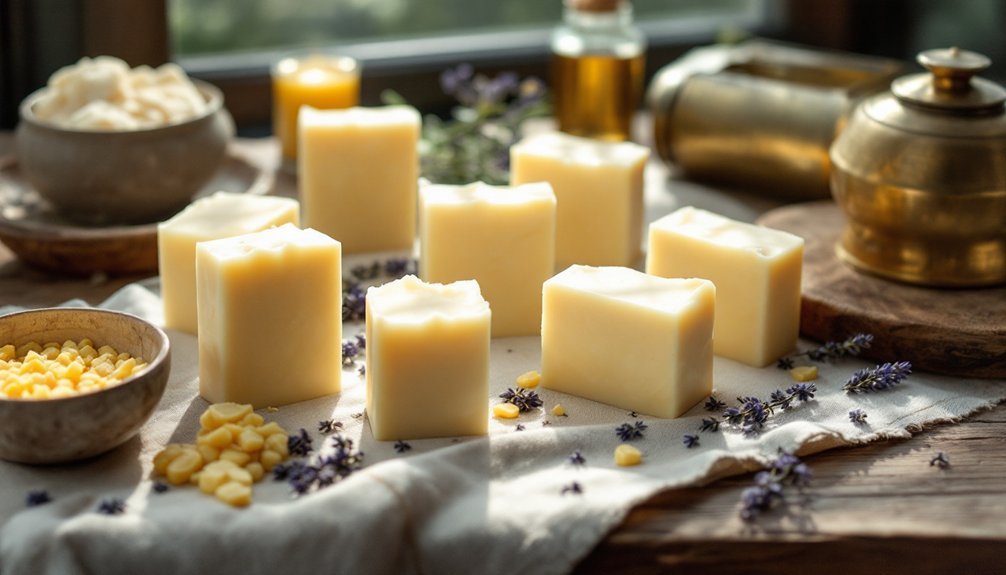



Leave a Reply